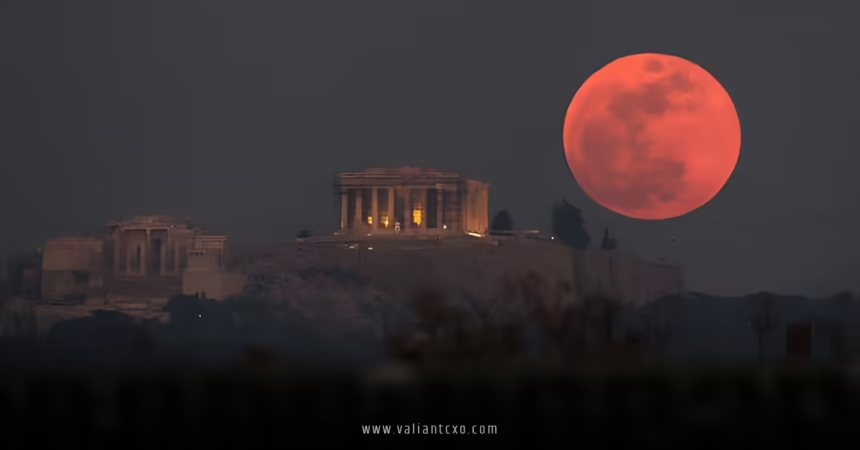Blood moon—a term that sparks curiosity, evokes wonder, and maybe even a touch of unease. Have you ever gazed up at the night sky and seen the moon glowing an eerie shade of red? It’s not just a trick of the light or a scene from a sci-fi movie. A blood moon is a real astronomical phenomenon that has fascinated humans for centuries, blending science, culture, and a dash of cosmic magic. In this article, we’ll dive deep into what makes a blood moon so special, why it happens, its cultural significance, and how you can catch this celestial show yourself. Ready to explore the crimson side of the moon? Let’s get started.
What Is a Blood Moon?
A b-l-o-o-d m-o-o-n occurs during a total lunar eclipse when the moon takes on a striking reddish hue. But what’s the science behind this captivating glow? When Earth passes between the sun and the moon, it casts a shadow that blocks direct sunlight from reaching the lunar surface. You’d think the moon would just disappear, right? Not quite. Instead, sunlight filters through Earth’s atmosphere, bending and scattering shorter blue and green wavelengths while allowing longer red wavelengths to pass through. This process, called Rayleigh scattering, bathes the moon in a warm, reddish glow—hence the name “blood moon.”
Think of it like a cosmic sunset. Just as the sky turns red during dusk because of the atmosphere’s filtering effect, a blood moon is Earth’s atmosphere painting the lunar canvas with shades of crimson, orange, or even copper. The exact color depends on factors like atmospheric conditions—dust, pollution, or volcanic particles can make the blood moon appear darker or more vivid.
Why Does the Blood Moon Look So Dramatic?
The drama of a b-l-o-o-d m-o-o-n isn’t just in its color; it’s in the rarity and the timing. Unlike solar eclipses, which require precise alignment and special viewing gear, a blood moon is visible to the naked eye across large parts of the world. It feels like a shared moment, a cosmic event that invites everyone to pause and look up. The moon, usually a soft silver, transforms into something otherworldly, stirring emotions from awe to apprehension. Is it any wonder ancient cultures spun tales around this phenomenon?
The Science Behind a Blood Moon
To understand a b-l-o-o-d m-o-o-n, we need to break down the mechanics of a lunar eclipse. A total lunar eclipse happens when the moon passes fully into Earth’s umbra, the darkest part of its shadow. This alignment—sun, Earth, moon—only occurs during a full moon, and even then, it’s not a monthly event. Why? The moon’s orbit is tilted about 5 degrees relative to Earth’s orbit around the sun, so perfect alignment is rare, happening only a few times a year at most.
The Role of Earth’s Atmosphere
Earth’s atmosphere is the unsung hero of the blood moon. Without it, the moon would simply go dark during an eclipse. As sunlight passes through the atmosphere, it scatters, and red light makes it through to illuminate the moon. The more particles in the atmosphere—like volcanic ash or smoke—the deeper and more intense the blood moon’s hue. For example, after major volcanic eruptions, blood moons have appeared almost apocalyptic, with a rich, rusty glow that feels straight out of a fantasy novel.
How Often Do Blood Moons Occur?
B-l-o-o-d m-o-o-n-s aren’t as rare as you might think, but they’re not an everyday event either. On average, total lunar eclipses happen about two to three times every three years, though not all are visible from every location. Some years might have none, while others, like 2014–2015, saw a rare “tetrad”—four blood moons in a row over two years. Curious about upcoming blood moons? Check NASA’s Eclipse Predictions for a detailed schedule of future eclipses.
Cultural and Historical Significance of the Blood Moon
The b-l-o-o-d m-o-o-n has left its mark on human history, weaving its way into myths, legends, and spiritual beliefs. Its striking appearance naturally inspired awe—and sometimes fear—across cultures. Let’s explore how different societies interpreted this crimson spectacle.
Ancient Civilizations and the Blood Moon
For ancient peoples, a blood moon was often a sign from the heavens. The Inca believed it signaled the moon being devoured by a jaguar, while some Mesoamerican cultures saw it as a time of sacrifice or upheaval. In ancient China, a blood moon was thought to be a dragon swallowing the moon, prompting loud rituals to scare the beast away. Can you imagine the cacophony of drums and shouts under a glowing red sky?
In Mesopotamia, one of the earliest civilizations, a blood moon was a dire omen. Kings would sometimes appoint a “substitute king” during an eclipse to bear the brunt of any cosmic wrath. Talk about a tough job! These stories highlight how deeply the blood moon stirred human imagination, blending fear with reverence.
Modern Interpretations and Symbolism
Today, the blood moon still carries symbolic weight. In some religious traditions, it’s tied to prophecies or apocalyptic events. For example, certain Christian interpretations link blood moons to biblical passages about the end times, particularly in the Book of Revelation. Meanwhile, in astrology, a blood moon is seen as a time of transformation, urging introspection and change. Whether you’re spiritual or not, there’s something undeniably powerful about a blood moon’s presence in the sky.
How to Observe a Blood Moon
Want to witness a blood moon yourself? The good news is, you don’t need fancy equipment or a PhD in astronomy. A blood moon is one of nature’s most accessible spectacles. Here’s how to make the most of it.
Finding the Next Blood Moon
First, you’ll need to know when and where a blood moon is happening. Websites like Time and Date provide user-friendly eclipse calendars. Blood moons are visible from any location where the moon is above the horizon during the eclipse, often covering half the globe. Unlike solar eclipses, they’re safe to view with the naked eye, so no special glasses are required.
Tips for the Best Viewing Experience
To catch a blood moon in all its glory, follow these tips:
- Check the weather: Clear skies are your friend. A cloudy night can hide even the most vibrant blood moon.
- Find a dark spot: Light pollution from cities can dim the moon’s glow. Head to a rural area or a park for the best view.
- Bring binoculars: While not necessary, binoculars or a telescope can enhance details like craters and maria (the moon’s dark patches).
- Time it right: A total lunar eclipse can last a few hours, with the blood moon phase (totality) typically lasting 30 minutes to an hour. Plan to settle in for the show.
Pro tip: Bring a blanket, some snacks, and maybe a friend or two. Watching a blood moon is like attending a cosmic concert—best enjoyed with good company.
Photographing a Blood Moon
Capturing a blood moon on camera can be tricky but rewarding. Use a DSLR or a smartphone with a good night mode, a tripod for stability, and a long exposure to capture the moon’s dim red glow. Experiment with settings, as the blood moon’s brightness varies. Want to learn more about astrophotography? Sky & Telescope has great resources for beginners.
Why Blood Moons Captivate Us
What is it about a blood moon that keeps us hooked? Maybe it’s the rarity—a fleeting moment when the universe reminds us of its grandeur. Or perhaps it’s the blend of science and mystery, where cold hard facts meet ancient stories. A blood moon feels like a bridge between the past and present, connecting us to ancestors who gazed at the same crimson orb with wonder and fear.
It’s also a reminder of our place in the cosmos. The moon, Earth, and sun align in a delicate dance, and we’re lucky enough to have a front-row seat. It’s humbling, isn’t it? In a world of screens and schedules, a blood moon pulls us outside, urging us to look up and marvel.
Blood Moons in Pop Culture
Blood moons have also infiltrated modern pop culture. From books like The Blood Moon Prophecy to movies and TV shows, the term evokes drama and intrigue. Musicians have penned songs about blood moons, and artists have used their imagery to capture the surreal. It’s like the blood moon is a universal symbol for change, mystery, and the unknown.
Common Myths and Misconceptions About Blood Moons
Despite their scientific explanation, blood moons are steeped in myths. Let’s debunk a few:
- Myth: A blood moon causes natural disasters.
Fact: There’s no evidence linking blood moons to earthquakes, tsunamis, or other catastrophes. They’re just beautiful alignments. - Myth: Blood moons are always a bad omen.
Fact: While some cultures saw them as ominous, others viewed them as signs of renewal or celebration. It’s all about perspective. - Myth: You need special equipment to see a blood moon.
Fact: Your eyes are all you need. Binoculars or telescopes are optional bonuses.
The Future of Blood Moons
Blood moons will continue to grace our skies as long as the Earth, moon, and sun keep their cosmic waltz. Scientists predict lunar eclipses centuries in advance, so you can plan your blood moon viewing well ahead. With climate change and atmospheric shifts, future blood moons might look slightly different—perhaps more vivid due to increased particles in the air. What will the blood moons of 2050 look like? Only time will tell.
Conclusion
A blood moon is more than just an astronomical event; it’s a moment that binds science, culture, and human curiosity. From the physics of Rayleigh scattering to the myths of ancient civilizations, the blood moon weaves a story that spans millennia. It’s a reminder to pause, look up, and appreciate the universe’s artistry. Whether you’re a stargazer, a history buff, or just someone who loves a good spectacle, the blood moon has something for you. So, mark your calendar for the next one, grab a cozy spot under the stars, and let the crimson moon work its magic. What’s stopping you from joining the cosmic show?
FAQs About Blood Moons
What causes a blood moon to appear red?
A blood moon turns red due to Earth’s atmosphere scattering sunlight during a total lunar eclipse, allowing red wavelengths to reach the moon.
How often can I see a blood moon?
Blood moons occur during total lunar eclipses, roughly two to three times every three years, though visibility depends on your location
Is a blood moon dangerous to look at?
No, a blood moon is completely safe to view with the naked eye, unlike a solar eclipse, which requires protective gear.
Do blood moons have any spiritual meaning?
Many cultures and spiritual traditions view a blood moon as a symbol of change, transformation, or significant events, though meanings vary.
Where can I find the schedule for the next blood moon?
Check trusted sites like NASA or Time and Date for accurate eclipse schedules to plan your blood moon viewing.
Click Here:valiantcxo.com


